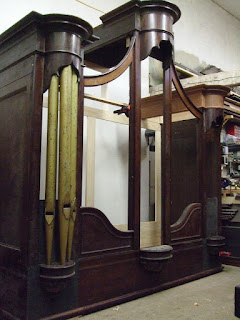The organ was painted blue when I first saw it in 2009 but has since been repainted.
The inside of the organ is very dusty and has not been used for many years. There is an ancient Taylor DC blower which gives off quite a few sparks when it is fired up. However despite providing a good flow of air the reservoir joints have completely come apart and only by holding the joints together can a feeble sound be produced. So the first thing to do is to remove the bellows assembly for repair. Because of the position of the organ up against a wall the only option was to remove the bellows through the side of the case work (completed 23 July).
Bellows coming out on a shallow trolley.
All out!
Some of the rubbish inside the organ!
Starting to reassemble the bellows. Starting with the ribs (24 July)
Partly reassembled reservoir (25 July)
Fully releathered reservoir (30 July, after a three day break - after one of the hottest weeks of the year!)
Releathered reservoir all strapped up and protected with cardboard strips ready to go back into the organ.
Reinstalling the reservoir into the organ case (31 July)
Collapsed principal pipes.
Collapse principal pipes from above
The original diaocton mechanism and pipes is still present - a Holdich speciality.
With the releathered reservoir and a more modern blower the organ was finally capable of making a reasonable sound. However, the pipework and mechanism still needs quite a bit of attention before the organ can be restored to something like its original sound. Chapter 2 will follow when time and money are available..


































